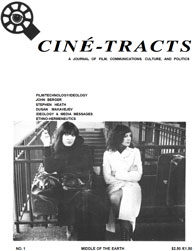John Avery continues the discussion
"I would like to add my own thoughts about dreaming: I think that one of the things that happens during dreaming is that data is transfered from a temporary mode of storage in the brain to a permanent mode. In this process, connections are made to previously stored associated data. Some of the associations that are tried and rejected are bizarre, and this, I believe, is why dreams often have a bizarre quality, while simultaneously including events stored in the temporary memory before sleep. Probably computers of the future will be able to reorganize their memories and to form associations in much the same way that the brain does. It is possible that computers of the future will also be capable of emotions."
Ron Burnett responds
I am not sure that we fully understand how the brain and the mind "store' memories. This is the difficulty with your comment. Gerald Edelman refers to the brain as part of a 'rich nervous system'. He does see memory as a process of categorization (something that computers could replicate) but then goes on to talk about the dynamic nature of neural populations and the continual process of change that characterizes the operations of the mind. This is important because if change is the main feature of thinking and remembering then it is likely that there is no fixed code for memory. The key question is whether computers could store ambiguous and continually evolving pathways of memory, where even the pathways themselves are open to change and transformation.
The other important question is whether it would be possible for computers to generate new properties, new ways of thinking and remembering. Our minds classify the world around us and then upset the applecart by dynamically combining complex properties gained from experience and the autonomous operations of the brain itself. Autonomy in this case means that the brain maps experiences and then recreates, transforms and recategorizes and then redistributes the entire flow in a way that we don't fully understand.
Further comment from Jan Visser
John's assumption falls in line with my own suggestion in my previous comment that dreaming has something to do with going beyond the immediacy of our perceptions and the processing thereof. This assumption seems to be supported by certain animal studies. It was already known that animals display REM sleep but it had not yet been established if this corresponds to actual dreaming. Recently, though, a 2001 MIT report of the Center for Learning and Memory states that “Animals have complex dreams and are able to retain and recall long sequences of events while they are asleep.? The same report places these findings against the scientific belief that “memories are formed in at least two stages: an initial process that occurs during the experience itself, followed by a consolidation period in which the experience is transformed into long-term memory. The hippocampus is believed to be involved in both stages.? As to the reason why animals dream, the findings in the report seem to suggest that “animals are capable of re-evaluating their experiences when they are not in the midst of them? and that such ability is not too far removed from the reason why humans dream.
According to Latrup’s remarks referred to by John, the emergence of dreaming would be a discontinuity in the evolution. If so, the quality of dreaming - the actual meaning of it from the point of view of conscious contemplation of the world - may equally be a discontinuity that distinguishes human beings from the other animals. However, evolutionary discontinuities do not represent changes of state from pitch black to brilliant white. There is a lot of gray in between and arguments may be construed (e.g. along the line of Michael Shermer’s “The science of good and evil?) to extend the concept of rights accorded to humans progressively to the animal kingdom and, why not, as machines become ever more lifelike, to machines. There would most certainly be an incredible benefit to the ecology of biological and physical resources if we became more conscious of such rights.
I am using the word ‘conscious’ in the above paragraph, thereby suggesting that a discussion of the capacity to dream in humans, animals and machines cannot be separated from questions about the meaning of consciousness in each of these categories, particularly moral consciousness. When I said earlier that “Perhaps we should [first] make machines enjoy the natural rhythm of their being? I was deliberately using language that pertains to the realm of consciousness. I am conscious and thus can enjoy (as well as suffer). The more I am conscious, the more I am able to enjoy and suffer, whence the traumatic experience of death in humans. Again, it’s not black and white and I am pervious to considerations about the suffering we inflict on animals other than ourselves as well as find it difficult to throw an outdated piece of computer equipment in the dustbin. I am also impressed by the display of humanlike emotions in primates when confronted with death, as for instance reported in the work of Frans de Waal of the Living Links Center.
End
 Tuesday, June 7, 2005 at 4:30AM
Tuesday, June 7, 2005 at 4:30AM 


